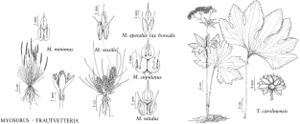Myosurus
Sp. Pl. 1: 284. 175.
Gen. Pl. ed. 5, 137. 1754.
Herbs, annual. Leaves basal, simple, tapering to filiform base. Leaf-blade linear or very narrowly oblanceolate, margins entire. Inflorescences terminal, solitary flowers; bracts absent. Flowers bisexual, radially symmetric; sepals not persistent in fruit, (3-) 5 (-8), green or with scarious margins, spurred, oblong to elliptic, lanceolate, or oblanceolate, 1.5-4 mm; petals 0-5, distinct, white, plane, linear to very narrowly spatulate, long-clawed, 1-2.5 mm; nectary present; stamens 5-25; filaments filiform; staminodes absent between stamens and pistils; pistils 10-400, simple; ovule 1 per pistil; style persistent. Fruits achenes, aggregate, sessile, prismatic, exposed face forming plane outer surface, sides faceted or curved by compression against adjacent achenes; sides not veined; beak terminal, straight, 0.05-1.8 mm. x=8.
Distribution
Temperate regions worldwide
Discussion
Species 15 (5 in the flora).
Mature fruits are crucial to accurate identification of most North American species of Myosurus.
Flowers of Myosurus are unique in the family in that the receptacle continues to elongate and, in some species, to initiate new ovaries after the flowers open and pollen is shed (D.E. Stone 1959).
Selected References
None.
Lower Taxa
Key
| 1 | Outer face of achene orbiculate to square or broadly rhombic, 0.8–1.3 times as high as wide. | > 2 |
| 1 | Outer face of achene narrowly rhombic to elliptic or oblong to linear, 1.5–5 times as high as wide. | > 3 |
| 2 | Outer face of achene bordered by prominent ridge. | Myosurus cupulatus |
| 2 | Outer face of achene not bordered. | Myosurus nitidus |
| 3 | Beak of achene 0.05–0.4 mm, 0.05–0.3 times as long as body of achene, parallel to outer face of achene, heads of achenes thus appearing smooth. | Myosurus minimus |
| 3 | Beak of achene 0.6–1.8 mm, 0.4–1.1 times as long as body of achene, divergent, heads of achenes thus strongly roughened by projecting achene beaks. | > 4 |
| 4 | Scapes 0–0.2 cm; heads of achenes immersed in leaves. | Myosurus sessilis |
| 4 | Scapes 0.9–10.5 cm; heads of achenes projecting beyond leaves. | Myosurus apetalus |
